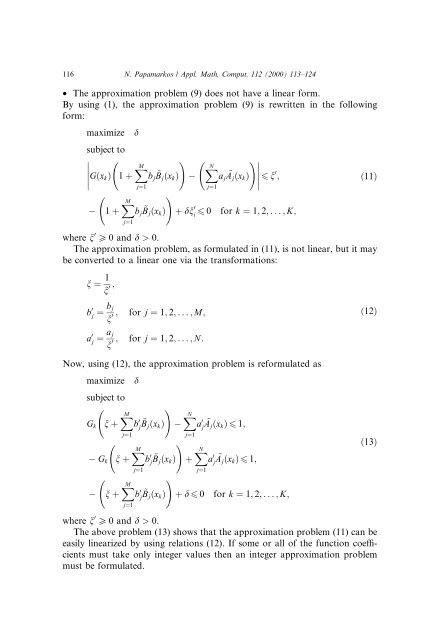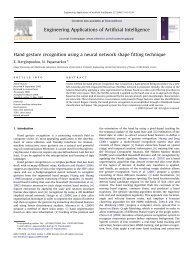On the approximation of real rational functions via mixed-integer ...
On the approximation of real rational functions via mixed-integer ...
On the approximation of real rational functions via mixed-integer ...
Create successful ePaper yourself
Turn your PDF publications into a flip-book with our unique Google optimized e-Paper software.
116 N. Papamarkos / Appl. Math. Comput. 112 (2000) 113±124· The <strong>approximation</strong> problem (9) does not have a linear form.By using (1), <strong>the</strong> <strong>approximation</strong> problem (9) is rewritten in <strong>the</strong> followingform:maximize dsubject to! G…x k † 1 ‡ XMbj~B j …x k † XNa j~A j …x k †!6 n 0 ;…11†jˆ1jˆ1! 1 ‡ XMb j~B j …x k † ‡ dn 0 i 6 0 for k ˆ 1; 2; ...; K;jˆ1where n 0 P 0 and d > 0.The <strong>approximation</strong> problem, as formulated in (11), is not linear, but it maybe converted to a linear one <strong>via</strong> <strong>the</strong> transformations:n ˆ 1n 0 ;b 0 j ˆ bjn 0 ; for j ˆ 1; 2; ...; M;…12†a 0 j ˆ ajn 0 ; for j ˆ 1; 2; ...; N:Now, using (12), <strong>the</strong> <strong>approximation</strong> problem is reformulated asmaximize dsubject to!n ‡ XMb 0 ~ jB j …x k † XNa 0 ~ jA j …x k † 6 1;G k G kjˆ1n ‡ XMn ‡ XMjˆ1jˆ1b 0 j ~ B j …x k †!jˆ1‡ XNjˆ1a 0 j ~ A j …x k † 6 1;!b 0 ~ jB j …x k † ‡ d 6 0 for k ˆ 1; 2; ...; K;…13†where n 0 P 0 and d > 0.The above problem (13) shows that <strong>the</strong> <strong>approximation</strong> problem (11) can beeasily linearized by using relations (12). If some or all <strong>of</strong> <strong>the</strong> function coecientsmust take only <strong>integer</strong> values <strong>the</strong>n an <strong>integer</strong> <strong>approximation</strong> problemmust be formulated.




